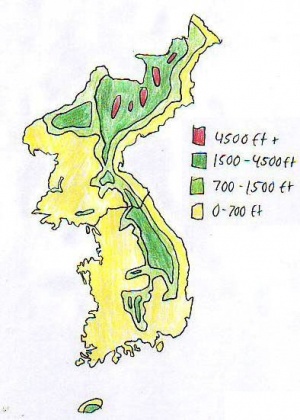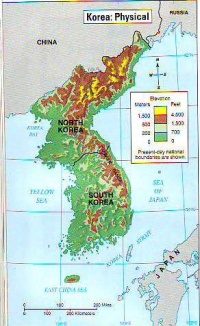Difference between revisions of "World Cultures Portfolio/Korea"
From ThePlaz.com
(edit from paper still need to add a bunch of ideas from textbook) |
m (→Sources: fix line break) |
||
| (6 intermediate revisions by one user not shown) | |||
| Line 8: | Line 8: | ||
[[Image:Korea Physical Map.jpg|thumb|300px|Korean Physical Map]] | [[Image:Korea Physical Map.jpg|thumb|300px|Korean Physical Map]] | ||
[[Image:Korea Physical Textbook.JPG|thumb|200px|Textbook Korean Physical Map]] | [[Image:Korea Physical Textbook.JPG|thumb|200px|Textbook Korean Physical Map]] | ||
| − | + | The rocky mountains of Korea shape its culture and society greatly. The eight mountain ranges restrict the amount of farmland available (Encyclopedia Mytha). Add an unstable political climate in the North, and the problem extends beyond mere geography. Rice and vegetables represent the primary crop of the Koreans (Ahmad et al 375). In addition, considerable industry has grown in the South because of its favorable political climate. The north, however, lacks these advancements. | |
| − | The rocky mountains of Korea shape its culture and society greatly. The | + | |
| − | The mountains | + | Mountains cover 70 percent of the Korean Peninsula (Ahmad et al 376). The T'aebaek mountain range runs on along the east of Korea. The mountains stand taller in Northern Korea then they do in South Korea. Only the north has mountains over 4,500 feet tall (Ahmad et al). These exist in the north-eastern section of the country. Less tall mountains surround them. Overall, the mountains lay mostly on the east side of Korea, leaving the west for farming and fishing. In addition, only about 25 percent of the Koreans live in the mountainous regions (Ahmad et al 376). This means that most of the citizens live in the coastal plains. |
| − | + | Commonly the coastal plains get split into three regions; the northeast, the west, and the southeast. The west coastal plain, however, hold both capital cities and most of the industry and population of the peninsula (Ahmad et al 376). In addition, Korea's 6,000 mile coastline makes fishing a big industry (Ahmad et al 376). Occasionally, disputes over fishing rights with Japan arise. | |
| − | + | The mountains of Korea severely limit the amount of farmland in the region. The CIA World Factbook 2006 reports that North Korean arable (farmable) land only makes up 22.4% of the country (USA CIA). South Korea has even less at only 16.58% (USA CIA). This severely limits agriculture, the "gateway" good to industrialization and global trade. Without it, Koreans must import much of their food, or increase the productivity of current farms. | |
| − | + | South Korea has managed to breed an industrial society. Tractors and modern farm equipment help make farms much more productive. Thus they can make more crops with less. In addition, the scientific research allows bigger and more disease resistant crops to grow. The south also has a strong industrial industry. The world buys semiconductors, wireless telecommunications equipment, motor vehicles, computers, steel, ships, and petrochemicals from Korea (USA CIA). | |
| − | + | North Korea, however, does not have their priorities straight. Its regime thinks only of itself and North Koreans worship their leader. The cities exist eerily quiet and the streets have no cars due to the oil shortage. But the monuments stand massively tall. Huge buildings stand empty, and much goes to waste. A small, select few have much wealth. But most North Koreans starve to death, live in prison camps, or prepare for war via forced military service. | |
| − | + | North Korea does have some natural resources however. Coal, iron, lead, copper, zinc and hydroelectric power all exist in North Korea (Ahmad et al 377). However, the government can not efficiently use these resources. Thus it receives little or no benefit from them. For society and for the Korean people, this does not represent a favorable situation. For the benefit of the entire world, this must change. | |
| + | |||
| + | The geography difference between each section of Korea does not differ as much as the difference between the economy and way of life in the respective countries. Perhaps it represents the most striking example of capitalism vs. communism. On one hand, a advanced, free nation making efficient use of its resources, and on the other hand, a poor, corrupt land not making efficient use of its resources. If the state controls all, the likelihood of this happening increases dramatically. | ||
| − | + | Like all of the other locations around the world, life in Korea depends on geography. Mountains prevent trade, but rivers encourage it. Mountains may have minerals to mine, but they limit arable land. However, geography does not determine all in Korea. Human have the possibility to affect more, especially now in the modern years when they have learned to move large amounts of earth. Everywhere, politics affects what can get done. Scientific climate and technological advances power the increases in productivity and has made life better for hundreds of thousands of people. Thus a nation must have not only the favorable geography, but the correct political climate to nurture industry, growth, and real advances in people's lives. | |
==Sources== | ==Sources== | ||
| − | *http://www.pantheon.org/ | + | *Ahmad, Ifikhar, Herbert Brodsky, Marylee Susan Crofts, and Elisabeth Gaynor Ellis. <u>World Cultures: A Global Mosaic</u>. Upper Saddle River, New Jersey: Prentice Hall, 2001. |
| − | * | + | *"Korean mythology." Encyclopedia Mythica. 2007. Encyclopedia Mythica Online. 16 Jan 2007 <http://www.pantheon.org/articles/k/korean_mythology.html>. |
| − | + | *United States. Central Intelligence Agency. “Korea, North.” <u>World Factbook</u>. 2006. 16 Jan 2007. <https://www.cia.gov/cia/publications/factbook/geos/kn.html>. | |
| − | * | + | *---. ---. “Korea, South.” <u>World Factbook</u>. 2006. 16 Jan 2007. <https://www.cia.gov/cia/publications/factbook/geos/ks.html>. |
Latest revision as of 23:13, 19 January 2007
World Cultures Korean Report about Physical Map
Intro/Basics - Africa - Middle East - South Asia - China - Japan - Korea - Latin America
Only spent one day on this unit World Cultures Daily Questions
Notebook
Portfolio
- Portfolio
- Physical Map Report
Africa: HDI Graph Reflections - Decolonization Report
Middle East: Population Density Report - Essay: A Peaceful Vacation
South Asia: Rainfall Report - South Asia Comparisons Graph - Postcards
China: Sphere of Influences Report - Mao Button Journal
Japan: Natural Resources Report - Japanese Violence Journal
Korea: Physical Map Report
Latin America: Landforms Report
Worldwide: T-Shirt Trade Report
The rocky mountains of Korea shape its culture and society greatly. The eight mountain ranges restrict the amount of farmland available (Encyclopedia Mytha). Add an unstable political climate in the North, and the problem extends beyond mere geography. Rice and vegetables represent the primary crop of the Koreans (Ahmad et al 375). In addition, considerable industry has grown in the South because of its favorable political climate. The north, however, lacks these advancements.
Mountains cover 70 percent of the Korean Peninsula (Ahmad et al 376). The T'aebaek mountain range runs on along the east of Korea. The mountains stand taller in Northern Korea then they do in South Korea. Only the north has mountains over 4,500 feet tall (Ahmad et al). These exist in the north-eastern section of the country. Less tall mountains surround them. Overall, the mountains lay mostly on the east side of Korea, leaving the west for farming and fishing. In addition, only about 25 percent of the Koreans live in the mountainous regions (Ahmad et al 376). This means that most of the citizens live in the coastal plains.
Commonly the coastal plains get split into three regions; the northeast, the west, and the southeast. The west coastal plain, however, hold both capital cities and most of the industry and population of the peninsula (Ahmad et al 376). In addition, Korea's 6,000 mile coastline makes fishing a big industry (Ahmad et al 376). Occasionally, disputes over fishing rights with Japan arise.
The mountains of Korea severely limit the amount of farmland in the region. The CIA World Factbook 2006 reports that North Korean arable (farmable) land only makes up 22.4% of the country (USA CIA). South Korea has even less at only 16.58% (USA CIA). This severely limits agriculture, the "gateway" good to industrialization and global trade. Without it, Koreans must import much of their food, or increase the productivity of current farms.
South Korea has managed to breed an industrial society. Tractors and modern farm equipment help make farms much more productive. Thus they can make more crops with less. In addition, the scientific research allows bigger and more disease resistant crops to grow. The south also has a strong industrial industry. The world buys semiconductors, wireless telecommunications equipment, motor vehicles, computers, steel, ships, and petrochemicals from Korea (USA CIA).
North Korea, however, does not have their priorities straight. Its regime thinks only of itself and North Koreans worship their leader. The cities exist eerily quiet and the streets have no cars due to the oil shortage. But the monuments stand massively tall. Huge buildings stand empty, and much goes to waste. A small, select few have much wealth. But most North Koreans starve to death, live in prison camps, or prepare for war via forced military service.
North Korea does have some natural resources however. Coal, iron, lead, copper, zinc and hydroelectric power all exist in North Korea (Ahmad et al 377). However, the government can not efficiently use these resources. Thus it receives little or no benefit from them. For society and for the Korean people, this does not represent a favorable situation. For the benefit of the entire world, this must change.
The geography difference between each section of Korea does not differ as much as the difference between the economy and way of life in the respective countries. Perhaps it represents the most striking example of capitalism vs. communism. On one hand, a advanced, free nation making efficient use of its resources, and on the other hand, a poor, corrupt land not making efficient use of its resources. If the state controls all, the likelihood of this happening increases dramatically.
Like all of the other locations around the world, life in Korea depends on geography. Mountains prevent trade, but rivers encourage it. Mountains may have minerals to mine, but they limit arable land. However, geography does not determine all in Korea. Human have the possibility to affect more, especially now in the modern years when they have learned to move large amounts of earth. Everywhere, politics affects what can get done. Scientific climate and technological advances power the increases in productivity and has made life better for hundreds of thousands of people. Thus a nation must have not only the favorable geography, but the correct political climate to nurture industry, growth, and real advances in people's lives.
Sources
- Ahmad, Ifikhar, Herbert Brodsky, Marylee Susan Crofts, and Elisabeth Gaynor Ellis. World Cultures: A Global Mosaic. Upper Saddle River, New Jersey: Prentice Hall, 2001.
- "Korean mythology." Encyclopedia Mythica. 2007. Encyclopedia Mythica Online. 16 Jan 2007 <http://www.pantheon.org/articles/k/korean_mythology.html>.
- United States. Central Intelligence Agency. “Korea, North.” World Factbook. 2006. 16 Jan 2007. <https://www.cia.gov/cia/publications/factbook/geos/kn.html>.
- ---. ---. “Korea, South.” World Factbook. 2006. 16 Jan 2007. <https://www.cia.gov/cia/publications/factbook/geos/ks.html>.




